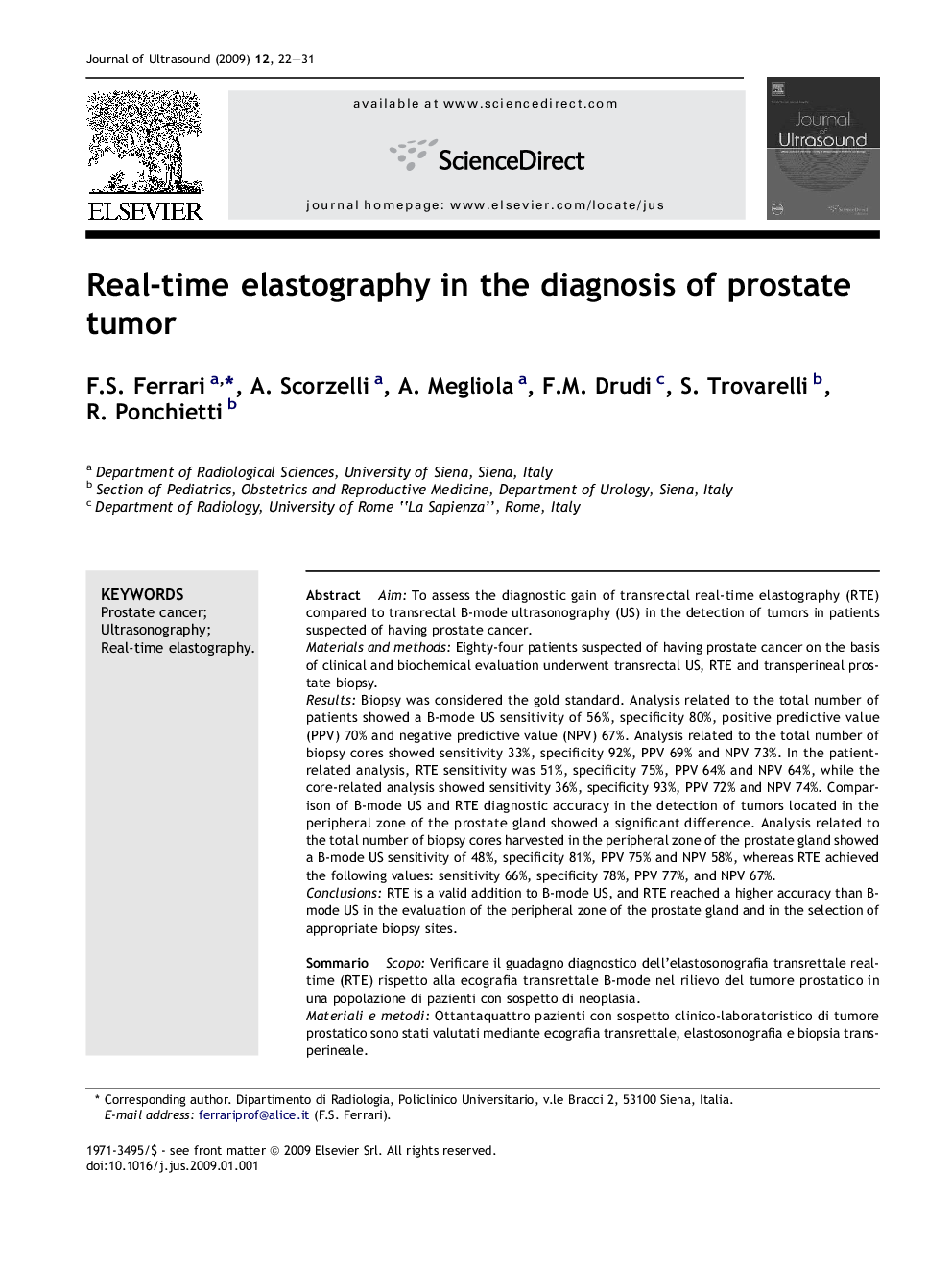| Article ID | Journal | Published Year | Pages | File Type |
|---|---|---|---|---|
| 4236950 | Journal of Ultrasound | 2009 | 10 Pages |
AimTo assess the diagnostic gain of transrectal real-time elastography (RTE) compared to transrectal B-mode ultrasonography (US) in the detection of tumors in patients suspected of having prostate cancer.Materials and methodsEighty-four patients suspected of having prostate cancer on the basis of clinical and biochemical evaluation underwent transrectal US, RTE and transperineal prostate biopsy.ResultsBiopsy was considered the gold standard. Analysis related to the total number of patients showed a B-mode US sensitivity of 56%, specificity 80%, positive predictive value (PPV) 70% and negative predictive value (NPV) 67%. Analysis related to the total number of biopsy cores showed sensitivity 33%, specificity 92%, PPV 69% and NPV 73%. In the patient-related analysis, RTE sensitivity was 51%, specificity 75%, PPV 64% and NPV 64%, while the core-related analysis showed sensitivity 36%, specificity 93%, PPV 72% and NPV 74%. Comparison of B-mode US and RTE diagnostic accuracy in the detection of tumors located in the peripheral zone of the prostate gland showed a significant difference. Analysis related to the total number of biopsy cores harvested in the peripheral zone of the prostate gland showed a B-mode US sensitivity of 48%, specificity 81%, PPV 75% and NPV 58%, whereas RTE achieved the following values: sensitivity 66%, specificity 78%, PPV 77%, and NPV 67%.ConclusionsRTE is a valid addition to B-mode US, and RTE reached a higher accuracy than B-mode US in the evaluation of the peripheral zone of the prostate gland and in the selection of appropriate biopsy sites.
SommarioScopoVerificare il guadagno diagnostico dell'elastosonografia transrettale real-time (RTE) rispetto alla ecografia transrettale B-mode nel rilievo del tumore prostatico in una popolazione di pazienti con sospetto di neoplasia.Materiali e metodiOttantaquattro pazienti con sospetto clinico-laboratoristico di tumore prostatico sono stati valutati mediante ecografia transrettale, elastosonografia e biopsia transperineale.RisultatiL'esame bioptico è stato considerato lo standard di riferimento. Nella valutazione per paziente, la sensibilità dell'ecografia B-mode è stata del 56%; la specificità dell'80%; il valore predittivo positivo (VPP) del 70%, il valore predittivo negativo (VPN) del 67%. Nella valutazione sul totale dei prelievi bioptici la sensibilità è stata del 33%, la specificità del 92%, il VPP del 69%, il VPN del 73%. La RTE ha ottenuto i seguenti risultati nella valutazione per paziente: sensibilità 51%, specificità 75%, VPP 64% e VPN 64%. Nella valutazione sul totale dei prelievi bioptici: sensibilità 36%, specificità 93%, VPP 72%, VPN 74%. Confrontando i valori di accuratezza dell'ecografia B-mode e della RTE per i tumori della zona periferica, è stata trovata una differenza significativa. Nella valutazione sul totale dei prelievi bioptici della zona periferica la sensibilità dell'ecografia B-mode è stata del 48%, la specificità dell'81%, il VPP del 75%, il VPN del 58%. La RTE ha ottenuto i seguenti valori: sensibilità 66%, specificità 78%, VPP 77%, VPN 67%.ConclusioniLa RTE rappresenta un valore aggiunto all'ecografia B-mode. Ha presentato un'accuratezza superiore rispetto all'esame B-mode nella valutazione della prostata periferica e nella possibilità di indirizzare i prelievi bioptici.
